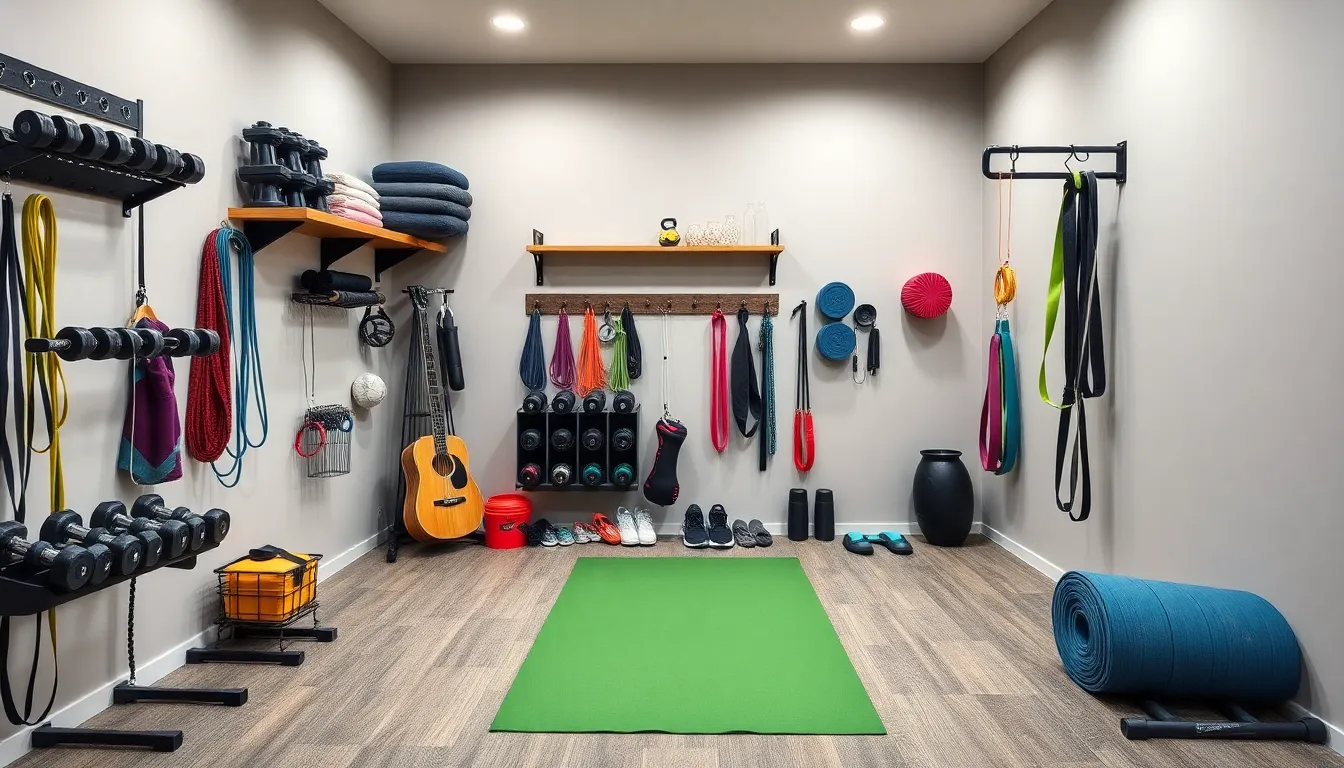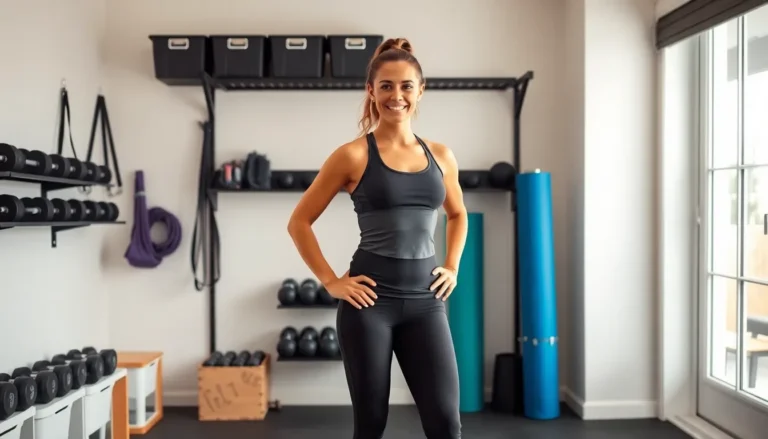Creating a home gym can feel like assembling a puzzle where half the pieces are missing and the other half are from a different set. With weights, mats, and resistance bands scattered around, finding motivation can be as tricky as finding that elusive pair of matching socks. But fear not! A well-organized home gym isn’t just a luxury; it’s a necessity for anyone serious about their fitness journey.
Table of Contents
ToggleImportance of Home Gym Organization
A well-organized home gym enhances focus and motivation. Clutter can distract from workout plans, leading to inconsistent routines. Effective organization allows easy access to equipment, minimizing time lost searching for necessary items.
Space optimization plays a crucial role in home gym design. Proper arrangement of weights, mats, and machines prevents overcrowding, ensuring safety during workouts. Organized storage solutions, such as shelves and bins, help maintain an orderly environment.
Structured environments contribute to mental clarity. Individuals often feel more inclined to exercise in tidy spaces, fostering positive workout habits. Achieving fitness goals becomes more attainable when equipment is readily available.
Efficiency improves with clear pathways and designated areas. Defined spaces can streamline exercises and make transitions smoother. Following a thoughtful layout reduces the chances of injury, promoting safer workouts.
Regular organization checks can enhance long-term motivation. Setting aside time to tidy up motivates individuals to remain consistent with their fitness journey. The effort spent on maintaining order compounds into substantial benefits on overall fitness progress.
Organizing a home gym directly contributes to improved physical health and mental well-being. Prioritizing proper organization establishes a supportive atmosphere for pursuing fitness objectives.
Key Elements of Effective Organization

Effective organization transforms a cluttered home gym into a focused workout environment. The right structure enhances motivation and supports fitness goals.
Space Utilization
Maximizing space creates an efficient workout area. Identify unused corners or walls for equipment placement. Zones for different activities promote an organized flow. Using vertical storage such as shelves or hooks can clear floors while maintaining access to items. Keeping frequently used equipment within arm’s reach prevents wasting time during workouts. Methods like folding equipment when not in use further enhance space efficiency.
Equipment Arrangement
Strategic equipment arrangement affects accessibility and safety. Place heavier items on lower racks to reduce the risk of injury during lifting. Group similar types of equipment together, such as weights and resistance bands. Position mats and cardio machines at designated areas to minimize distractions. Regularly assess equipment arrangement as it evolves with workout needs. Maintaining clear pathways to essential items furthers safety and ensures an efficient workout experience.
Storage Solutions
Thoughtful storage solutions streamline organization significantly. Opt for containers or bins for smaller items, keeping them grouped for easy identification. Use labeled boxes or racks to make finding equipment quick and straightforward. Wall-mounted organizers can save floor space while maintaining visibility. In addition, drawers can house accessories like towels or nutritional snacks effectively. Regular evaluation of storage solutions ensures that they adapt to changing fitness routines, keeping the gym tidy and functional.
Home Gym Layout Ideas
Creating an efficient home gym layout enhances motivation and encourages consistent workouts. Strategic organization leads to a space that feels inviting and functional.
Design Templates
Various design templates can transform a home gym into a personal fitness sanctuary. Open floor plans encourage movement and versatility in workouts. Angled layouts utilize corners effectively, making spaces feel larger without overcrowding. Vertical storage options, such as wall-mounted racks, save floor space while keeping equipment easily accessible. Color schemes play a vital role as well; lighter colors can brighten a space and make it feel more energizing. Adding mirrors creates a perception of more space and helps with form during exercises.
Functional Zones
Functional zones optimize workout efficiency by categorizing equipment and activities. Cardio areas should feature machines like treadmills and stationary bikes, providing ample room for movement. Resistance training zones should accommodate weights, bars, and benches while ensuring safety and accessibility. Stretching or yoga spaces require open areas with mats, allowing for comfortable movements. Grouping similar equipment together facilitates easy transitions between exercises. Clearly defining these zones minimizes distractions, keeping sessions focused and productive.
Tips for Maintaining Organization
Maintaining an organized home gym requires consistent effort and strategic planning. Effective practices transform a cluttered space into a motivating environment.
Regular Decluttering
Decluttering holds significant importance for keeping a home gym organized. Setting aside time weekly to remove unused items helps maintain an orderly space. Disposing of or donating equipment that is no longer used creates room for new favorites. Moreover, focusing on the essentials allows individuals to prioritize key workout tools, reinforcing commitment to fitness goals. Consistent checks on storage solutions, like shelves and bins, prevent overloading and encourage easy access. By regularly reassessing equipment and minimizing distractions, staying motivated becomes much simpler.
Smart Inventory Management
Smart inventory management plays a crucial role in home gym organization. Keeping an updated list of equipment enhances equipment accessibility and efficiency. Storing items in clearly labeled containers streamlines the process of finding necessary tools. Integrating digital tracking apps can also assist in monitoring which equipment is regularly used. Categorizing items based on type, such as weights, cardio gear, or mats, simplifies routines and encourages focused workouts. Regular inventory checks help adapt to evolving fitness goals and maintain a tidy surroundings. Tracking equipment’s usage not only promotes efficiency but also supports long-term commitment to health and fitness.
A well-organized home gym can make all the difference in achieving fitness goals. By creating a space that’s tidy and functional, individuals can enhance their focus and motivation. Regular maintenance and strategic planning are key to sustaining this organized environment.
Incorporating smart storage solutions and thoughtful layouts not only optimizes space but also ensures safety during workouts. As fitness routines evolve, staying adaptable with organization practices will support long-term success.
Ultimately, a clutter-free gym fosters a positive mindset, making it easier to stay committed to a healthier lifestyle. Embracing these organization strategies transforms the home gym into a motivating sanctuary for fitness enthusiasts.







